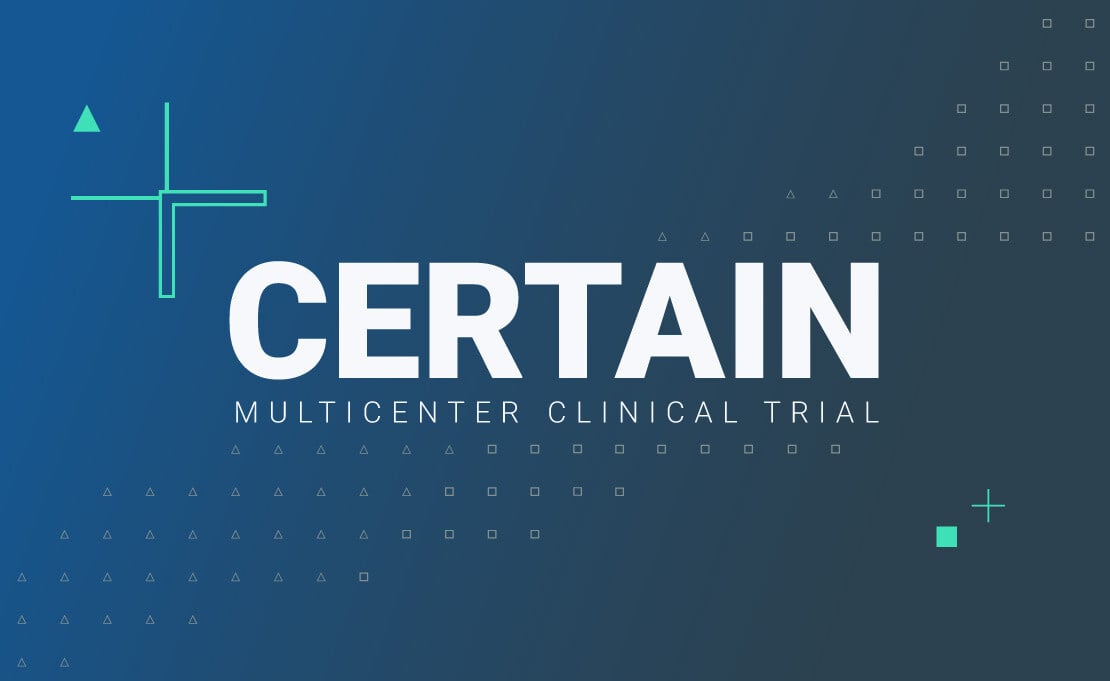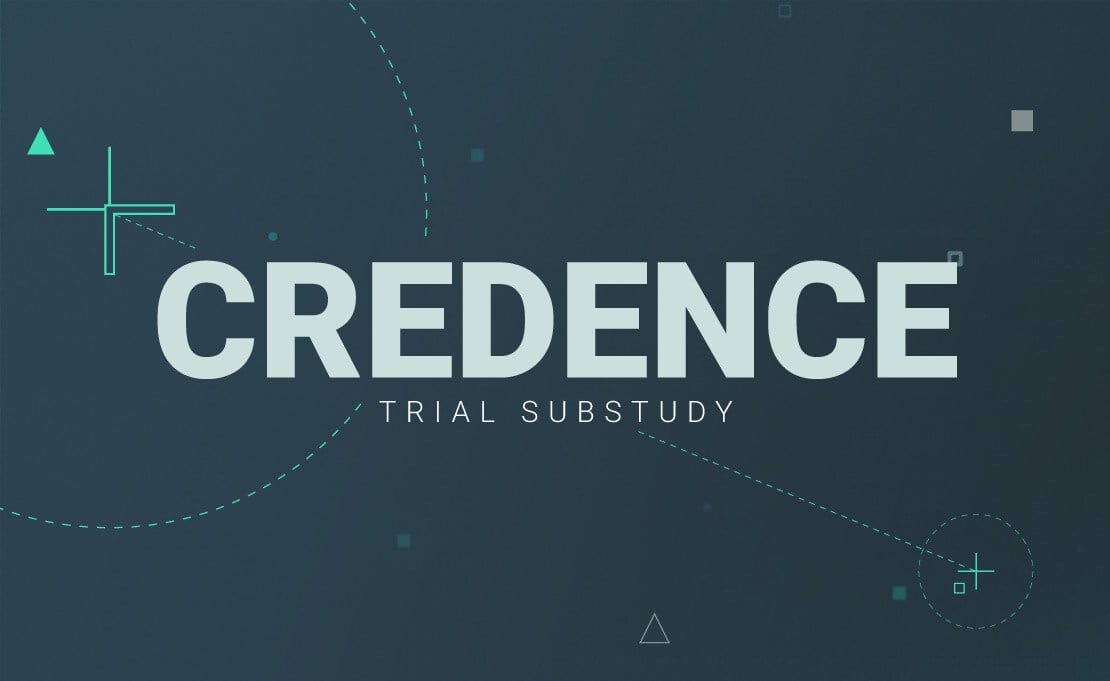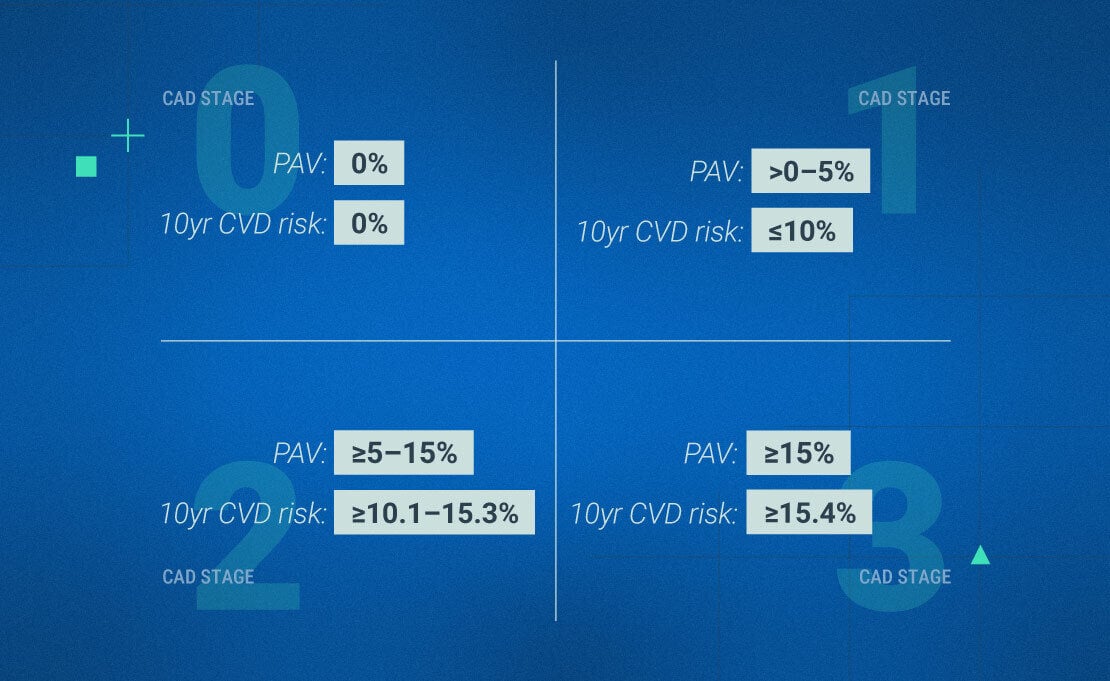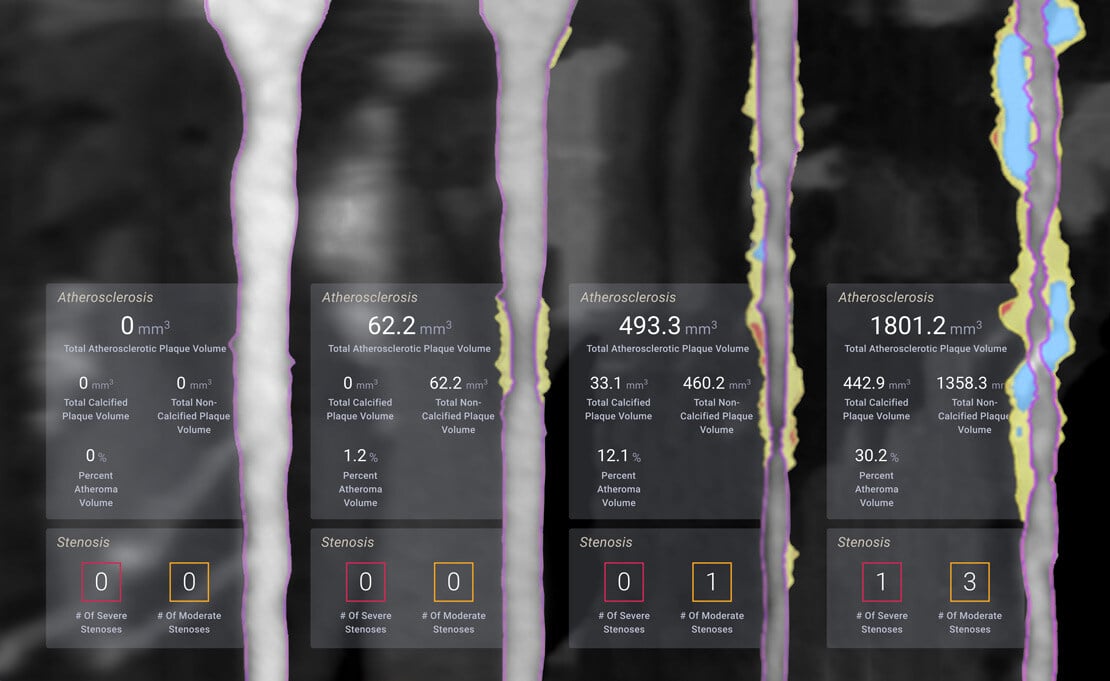Publications
Enter a keyword in the search bar below and publication options will populate.
Featured Publications

Post Hoc Analysis of CREDENCE and PACIFIC-1
Development and Validation of a Quantitative Coronary CT Angiography Model for Diagnosis of Vessel-Specific Coronary Ischemia
Named a 2024 top 10 paper in ischaemic heart disease by European Heart Journal.
Nurmohamed, et al.
JACC: Cardiovascular Imaging
Volume 17, Issue 8, August 2024
This newly developed coronary CTA-based ischemia model using coronary atherosclerosis and vascular morphology characteristics accurately diagnoses coronary ischemia by invasive FFR and provides robust prognostic utility for MACE beyond presence of stenosis.

CERTAIN
Impact of Atherosclerosis Imaging-Quantitative Computed Tomography on Diagnostic Certainty, Downstream Testing, Coronary Revascularization, and Medical Therapy: The CERTAIN Study
Nurmohamed, et al.
European Heart Journal – Cardiovascular Imaging
Volume 25, Issue 6, June 2024
The use of AI-QCT improves diagnostic certainty and may result in reduced downstream need for non-invasive testing and increased rates of preventive medical therapy.

A CREDENCE Trial Substudy
AI Evaluation of Stenosis on Coronary CT Angiography, Comparison With Quantitative Coronary Angiography and Fractional Flow Reserve
Griffin, et al.
JACC: Cardiovascular Imaging
Volume 16, Issue 2, February 2023
A novel AI-based evaluation of coronary CTA enables rapid and accurate identification and exclusion of high-grade stenosis and with close agreement to blinded, core lab–interpreted quantitative coronary angiography.

AI-Guided Quantitative Plaque Staging Predicts Long-Term Cardiovascular Outcomes in Patients at Risk for Atherosclerotic CVD
Nurmohamed, et al.
JACC: Cardiovascular Imaging
Volume 17, Issue 3, March 2024
Through 10-year follow-up, AI-QCT plaque staging showed important prognostic value for MACE and showed additional discriminatory value over clinical risk factors, CACS, and manual guideline-recommended CCTA assessment.

Integrating Coronary Atherosclerosis Burden and Progression with Coronary Artery Disease Risk Factors to Guide Therapeutic Decision Making
Freeman, et al.
The American Journal of Medicine
Volume 136, Issue 3
The American College of Cardiology Innovations in Prevention Working Group introduce the Atherosclerosis Treatment Algorithms that personalize medical interventions based upon atherosclerosis findings from coronary computed tomography angiography (CTA) and cardiovascular risk factors.
Prognosis
CTA-Derived Plaque Characteristics and Risk of Acute Coronary Syndrome in Patients With Coronary Artery Calcium Score of Zero: Insights From the ICONIC Trial
Rebecca A Jonas et al.
American Journal of Roentgenology
Diagnostic Accuracy
Factors affecting the performance of a novel artificial intelligence-based coronary computed tomography-derived ischaemia algorithm
Peerapon Kiatkittikul et al.
European Heart Journal - Cardiovascular Imaging
Prognosis
AI-Quantitative CT Coronary Plaque Features Associate with a Higher Relative Risk in Women: CONFIRM2-Registry;
Gudrun Feuchtner et al.
Circulation: Cardiovascular Imaging
Prognosis
CCTA-Derived Coronary Plaque Burden Offers Enhanced Prognostic Value Over CAC Scoring In Suspected CAD Patients
Jorge Dahdal et al.
European Heart Journal - Cardiovascular Imaging
Prognosis
Derivation and Validation of an Artificial Intelligence-Based Plaque Burden Safety Cut-Off for Long-Term Acute Coronary Syndrome from Coronary Computed Tomography Angiography
Sarah Bär et al.
European Heart Journal - Cardiovascular Imaging
Prognosis
Plaque burden improves the detection of ischemic CAD over stenosis from coronarycomputed tomography angiography
Tanja Kero et al.
International Journal of Cardiovascular Imaging
Diagnostic Performance
Artificial intelligence quantification and experienced reader computed tomography analysis for differentiating normal from minimally and mildly diseased coronary arteries: an early real-world compatibility study
Amr Idris, Victor Cheng et al.
International Journal of Cardiovascular Imaging
Diagnostic Accuracy
Diagnostic accuracy in coronary CT angiography analysis: artificial intelligence versus human assessment
Bernardo et al.
Open Heart
Correspondance
Lipoprotein(a) and coronary artery disease burden in patients with diabetes
Salvas JP et al.
JCCT
Changes in Patient Management
Artificial Intelligence-Enhanced Coronary Computed Tomography Angiography for Chronic Coronary Total Occlusion Percutaneous Coronary Intervention
Pedro Carvalho et al.
JACC Imag
Diagnostic Accuracy
First comparison between artificial intelligence-guided coronary computed tomography angiography versus single-photon emission computed tomography testing for ischemia in clinical practice
Geoffrey Cho et al.
Coron Art Dis
Clinical Utility
Artificial Intelligence-Enhanced Coronary Computed Tomography Angiography for Chronic Coronary Total Occlusion Percutaneous Coronary Intervention
Pedro E.P. Carvolho et al.
JACC: Cardiovascular Interventions
Clinical Utility
Atherosclerosis Quantification and Cardiovascular Risk: The ISCHEMIA Trial
Nick Nurmohamed et al.
EHJ
New Biology
Polygenic Risk Is Associated With Long-Term Coronary Plaque Progression and High-Risk Plaque
Nick Nurmohamed et al.
JACC CV Imaging
Prognosis
Location-Specific Prognostic Significance of Plaque Burden, Stenosis, and Plaque Morphology in Coronary Artery Disease
Ruurt Jukema et al.
EHJ - Cardiovascular Imaging
New Biology
Lipoprotein(a) and Long-Term Plaque Progression, Low-Density Plaque, and Pericoronary Inflammation
Nick Nurmohamed et al.
JAMA Cardiology
Diagnostic Performance
Performance of an Artificial Intelligence-Guided Quantitative Coronary Computed Tomography Algorithm for Predicting Myocardial Ischemia in Real-World Practice
Ron Karlsberg et al.
IJC Heart and Vasculature
New Biology
Beyond Early LDL Cholesterol Lowering to Prevent Coronary Atherosclerosis in Familial 2 Hypercholesterolemia
Shirin Ibrahim et al.
European Journal of Preventive Cardiology
New Biology
Decreased LDL-Cholesterol Exposure Following ANGPTL3 Inhibition Reduces Coronary Plaque Development in Homozygous Familial Hypercholesterolemia
Willemijn Schonck et al.
JACC CV Imaging
Reimbursement
Impact of Atherosclerosis Imaging-Quantitative Computed Tomography on Diagnostic Certainty, Downstream Testing, Coronary Revascularization and Medical Therapy: The CERTAIN Study
Nick Nurmohamed et al.
EHJ Imaging
Review Paper
Atherosclerosis Evaluation and Cardiovascular Risk Estimation Using Coronary Computed Tomography Angiography
Nick Nurmohamed et al.
EHJ
Diagnostic Performance
Assessment of Atherosclerotic Plaque Burden: Comparison of AI-QCT Versus SIS, CAC, Visual and CAD-RADS Stenosis Categories
Hufsa Khan et al.
International Journal of Cardiovascular Imaging
Diagnostic Performance
Prognostic Value of a Novel Artificial Intelligence-Based Coronary Computed Tomography Angiography-Derived Ischemia Algorithm for Patients with Suspected Coronary Artery Disease
Sarah Bär et al.
EHJ CV Imaging
Diagnostic Performance
Incremental Prognostic Value of a Novel Artificial Intelligence-based CCTA-Derived Ischemia Algorithm Among Patients with Normal and Reduced Myocardial Perfusion
Sarah Bär et al.
JCCT
Diagnostic Performance
Development and Validation of a Quantitative Coronary CT Angiography Model for Diagnosis of Vessel-Specific Coronary Ischemia
Nick Nurmohamed et al.
JACC CV Imaging
Diagnostic Performance
Artificial Intelligence Coronary Computed Tomography, Coronary Computed Tomography Angiography Using Fractional Flow Reserve, and Physician Visual Interpretation in the Per-Vessel Prediction of Abnormal Invasive Adenosine Fractional Flow Reserve
Andrew Chiou et al.
EHJ Imaging Methods
Diagnostic Performance
The Effect of Tube Voltage on Scan-Rescan Reproducibility of Compositional Plaque Volume: Technical Variability is Not True Biological Change
Francesca Calicchio et al.
EHJ Imaging Methods
Clinical Utility
Distal-Vessel Fractional Flow Reserve by Computed Tomography to Monitor 1 Epicardial Coronary Artery Disease
Chen et al.
EHJ - Cardiovascular Imaging
Clinical Utility
Diabetes, Atherosclerosis, and Stenosis by AI
Jonas et al.
Diabetes Care
Clinical Utility
Relationship of Sex to Atherosclerotic Plaque Characteristics by Differing Angiographic Stenosis Severity
Jonas et al.
American Journal of Cardiology
Clinical Utility
Impact of Visceral Fat on Coronary Artery Disease as Defined by Quantitative Computed Tomography Angiography
Karlsberg et al.
Obesity
Clinical Utility
Comparison of Coronary Artery Calcium and Quantitative Coronary Plaque in Predicting Obstructive Coronary Artery Disease: Subgroup Analysis of CLARIFY Study
Manubolu et al.
Heart International
Clinical Utility
AI-Guided Quantitative Plaque Staging Predicts Long-Term Cardiovascular Outcomes in Patients at Risk for Atherosclerotic CVD
Nurmohamed et al.
JACC CV Imaging
Diagnostic Performance
How Early Can Atherosclerosis Be Detected by Coronary CT Angiography? Insights From Quantitative CT Analysis of Serial Scans in the PARADIGM Trial
Cardoso et al.
JCCT
Diagnostic Performance
Determination of Lipid-Rich Plaques by Artificial Intelligence-Enabled Quantitative Computed Tomography Using Near-infrared Spectroscopy as Reference
Omori et al.
Atherosclerosis
Methodology Paper
Rationale and Design of the INVICTUS Registry
Nakanishi et al.
JCCT
Methodology Paper
Rationale and Design of the CONFIRM2 Study
van Rosendael et al.
JCCT
New Biology
Endothelial Shear Stress Computed from Coronary Computed Tomography Angiography: A Direct Comparison to Intravascular Ultrasound
Hakim et al.
JCCT
Reimbursement
Atherosclerosis Imaging Quantitative Computed Tomography (AI‐QCT) to Guide Referral to Invasive Coronary Angiography in the Randomized Controlled CONSERVE Trial
Kim et al.
Clinical Cardiology
Clinical Utility
Plaque Progression Differences Between Apixaban and Rivaroxaban in Patients With Atrial Fibrillation Measured With Cardiac Computed Tomography and Plaque Quantification
Aldana-Bitar et al.
American Journal of Therapeutics
Clinical Utility
Serial Analysis of Coronary Artery Disease Progression by Artificial Intelligence Assisted Coronary Computed Tomography Angiography: Early Clinical Experience
Chen et al.
BMC Cardiovascular Disorders
Clinical Utility
Quantitative Plaque Analysis with A.I.-Augmented CCTA in End-Stage Renal Disease and Complex CAD
Cho et al.
Cardiothoracic Imaging
Clinical Utility
Integrating Coronary Atherosclerosis Burden and Progression with Coronary Artery Disease Risk Factors to Guide Therapeutic Decision Making
Min et al.
JCCT
Diagnostic Performance
AI Evaluation of Stenosis on Coronary CT Angiography, Comparison With Quantitative Coronary Angiography and Fractional Flow Reserve: A CREDENCE Trial Substudy
Griffin et al.
JACC CV Imaging
Diagnostic Performance
The Effect of Scan and Patient Parameters on the Diagnostic Performance of AI for Detecting Coronary Stenosis on Coronary CT Angiography
Jonas et al.
Clinical Imaging
Diagnostic Performance
Interobserver Variability Among Expert Readers Quantifying Plaque Volume and Plaque Characteristics on Coronary CT Angiography: a CLARIFY Trial Sub-Study
Jonas et al.
Clinical Imaging
Diagnostic Performance
Coronary CTA With AI-QCT Interpretation: Comparison With Myocardial Perfusion Imaging for Detection of Obstructive Stenosis Using Invasive Angiography as Reference Standard
Lipkin et al.
American Journal of Roentgenology
Review Paper
Cardiac CT Angiography in Current Practice: An American Society for Preventive Cardiology Clinical Practice Statement
Budoff et al.
American Journal of Roentgenology
Review Paper
Artificial Intelligence Advancements in the Cardiovascular Imaging of Coronary Atherosclerosis
Covas et al.
Frontiers in Cardiovascular Medicine
Review Paper
Integrating Coronary Atherosclerosis Burden and Progression with Coronary Artery Disease Risk Factors to Guide Therapeutic Decision Making
Freeman et al.
American Journal of Medicine
Clinical Utility
Relationship of Age, Atherosclerosis and Angiographic Stenosis Using Artificial Intelligence
Jonas et al.
Open Heart
Diagnostic Performance
CT Evaluation by Artificial Intelligence for Atherosclerosis, Stenosis and Vascular Morphology (CLARIFY): A Multi-Center, International study
Choi et al
JCCT
Editorial
The Multidimensionality of Coronary Artery Disease: Combining, Conflating and Changing
Min et al.
JACC: Asia
Review Paper
Quantitative Assessment of Atherosclerotic Plaque, Recent Progress and Current Limitations
Williams et al.
JCCT